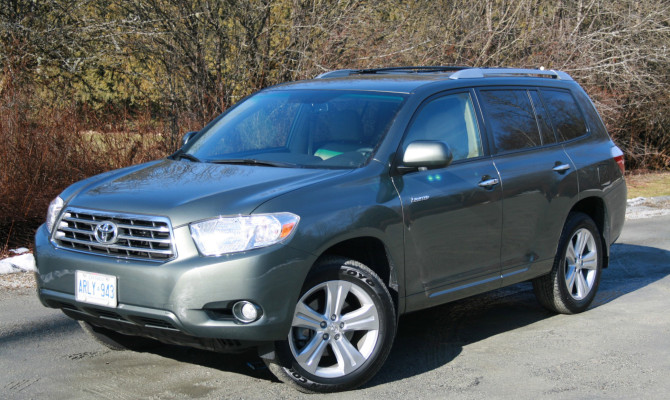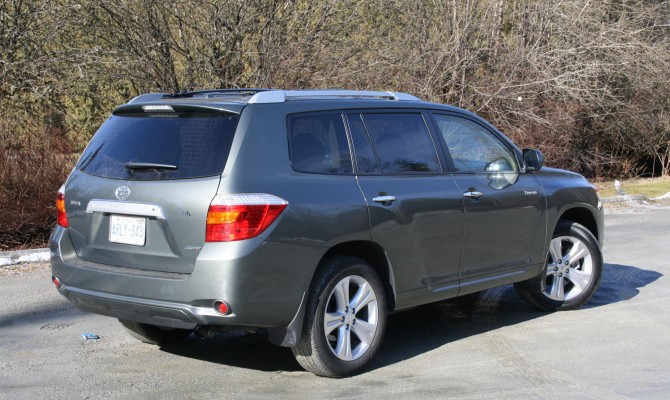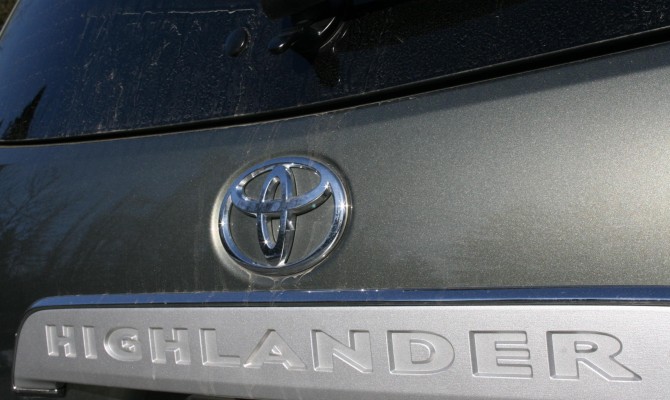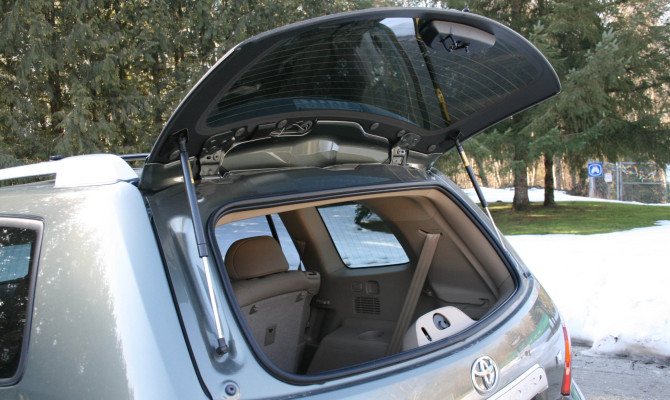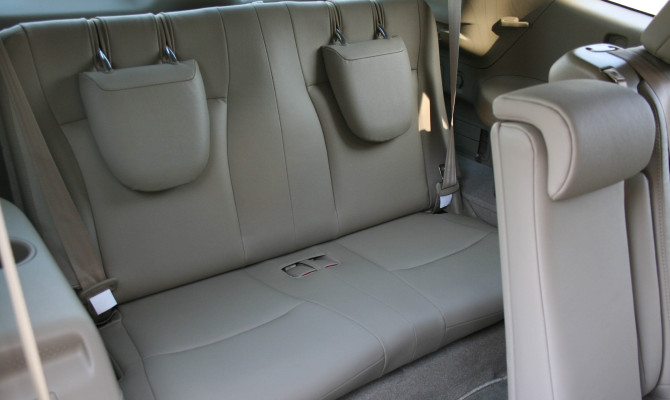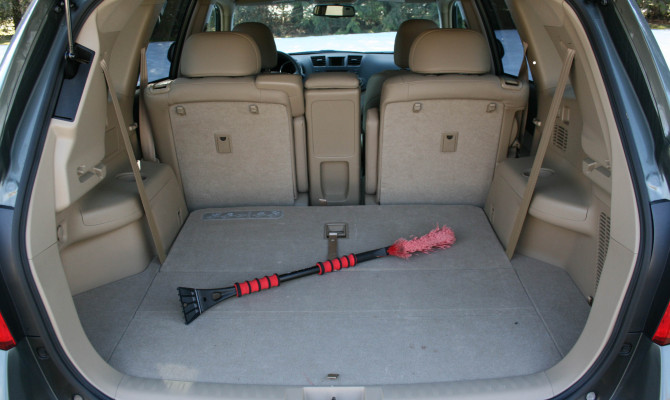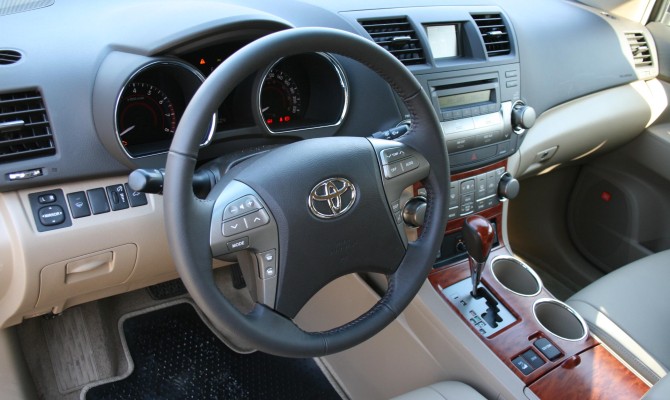“A comfortable and secure all-weather family cruiser, the Toyota Highlander is a low risk purchase with a history of solid reliability and excellent resale value retention.”
Toyota introduced a completely redesigned and more upscale Highlander in 2008 (its mid-sized utility vehicle) that was bigger with three rows of seating, more powerful and more expensive.
Bad timing, as that very same year the world`s economy took an unexpected and spectacular nosedive, which sparked a major consumer trend to scale down.
This model offers has a more rounded shape with pronounced wheel arches and there’s a flip-open rear door window. It`s a handy feature that allows you to drop stuff into the cargo area without opening the large rear door.
The V6 engine versions of Highlander came with four-wheel-drive plus extra goodies like a back-up camera, a power driver’s seat and fog lamps. Above base, the higher trim levels were Sport, Limited and SR5 (only for 2008).
A four-wheel-drive Highlander Hybrid with a gas/electric powertrain was also offered and came in base and Limited trim levels. Hybrid power is provided by a 3.3 litre V6 engine coupled to an electric motor and they have a combined power output of 270 horsepower, which is roughly the same as the regular 3.5-litre V6. The hybrid`s city/highway fuel economy, however, is rated (new five-cycle method) at 8.6 / 9.5 L/100km compared to 13.8 / 10.4 km/100km for the 3.5 litre V6.
Reacting to the new economic reality, in an impressively quick way, Toyota introduced a substantially lower priced and more basic, front-drive Highlander, midway through the ’09 model year. It came with two-row seating and a 2.7 litre 4-cylinder engine mated to a 6-speed automatic transmission. This engine can provide 187 horsepower and 186 lb-ft of torque at 4,100 rpm and its city/highway fuel economy rating is 11.8 / 8.7 L/100km.
Highlander is a ‘Top Safety Pick’ according to the Insurance Institute for Highway Safety, based on its front, side and rear crash tests. Highlander was included in a series of safety recalls (see list), including the famous “floor mat recall”, in response to mysterious defect that supposedly caused unintended acceleration.
No changes were made to the 2010 Highlander, but for 2011, it got revised front and rear styling, with slimmer headlights, a new front grille and new taillights. The Sport model was discontinued and the hybrid version got a (combined 280 horsepower) 3.5L V6. A third-row seat also became standard on all models.
No significant changes were made for the 2012 or 2013 model years, which were the last of this generation Highlander. The completely revised 2014 Highlander, a sleeker family-friendly seven passenger cross utility, recorded its best sales year ever.
A comfortable and secure all-weather family cruiser, the Toyota Highlander is a low risk purchase with a history of solid reliability and excellent resale value retention.
Price Check: 2008 – 2013 Toyota Highlander (April 2015)
Year Edition Expect to Pay Today
2008 V6 4WD Limited $21,000 to $25,000
2009 V6 4WD Limited $23,000 to $27,000
2010 V6 4WD Limited $25,000 to $29,000
2011 V6 4WD Limited $27,000 to $32,000
2012 V6 4WD Limited $30,000 to $35,000
2013 V6 4WD Limited $33,000 to $38,000
Prices vary depending on a used vehicle’s condition, mileage, usage and history. A complete mechanical check should always be performed by a reliable auto technician prior to purchase.
Safety Recalls: 2008 to 2013 Toyota Highlander:
2008: The driver’s side power window master switch could stick or become inoperative. Dealers will inspect the driver’s power window master switch and apply special grease that inhibits heat build-up, or replace the power window master switch circuit board, as necessary.
2008: Side curtain airbag roll angle sensors may fail. If one roll angle sensor malfunctions, the airbag warning lamp will illuminate and the roll detection system will be suspended. If both roll angle sensors fail simultaneously, the curtain shield airbag and the seatbelt pre-tensioner could inadvertently deploy. Dealers will replace the airbag sensor assembly.
2008: The seatbelt mechanism for the third row seat may revert from its Emergency Locking Retractor (ELR) mode to its Automatic Locking Retractor (ALR) mode, while installing a Child Restraint. Dealers will install a newly designed seatbelt component free of charge.
2008: The seat track, located on the inboard side of the left second row seat, may not fully lock in the forward first and second adjustment positions. Dealers will affect repairs.
2008 – 2010: Electrical circuitry in the steering wheel assembly may become damaged and the driver’s airbag may not function as intended and the instrument panel airbag warning lamp may illuminate. Dealers will replace the spiral cable assembly.
2008 – 2010: If a Toyota optional accessory “tray-type” floor mat is not secured by retaining hooks, or is placed on top of an existing floor mat, it may move forward and interfere with the accelerator pedal. Owners were notified to remove the “tray-type” floor mats and given a reimbursement.
2008 – 2010: The accelerator pedal may become stuck in the wide-open position due to an unsecured or incompatible driver’s floor mat. Dealers will reconfigure the shape of the accelerator pedal, modify the floor underneath the accelerator pedal and/or install a brake override system.
Recent Comments
- { Enjoyed your Forest of Bowland in the BMW X5M, particularly the photo of the BMW in front of the main part of Stonyhurst College where... }
- { Bantam designed the Jeep, not Willy's or Ford. The American military gave the original Bantam prototype to Willys and Ford to copy. There is plenty... }
- { All Escalades come with a 6.2-lilter V8 engine that produces 420 horsepower. A six-speed automatic is the only transmission offered and drives the rear wheels.... }
- { Alexandra is an excellent journalist. }
Popular Posts
- Journey to a ‘Sparkling’ Luxury Okanagan Resort “Four lucky readers will put a Dodge Journey’s weekend-...
- The Need For Speed: Hike Those Highway Limits More than half of those polled believe the province sho...
- Drives-U-Crazy… Erratic drivers. An early morning drive from Kelowna to Vancouver is nor...
- Readers Respond: The Pros and Cons of Increasing B.C. Speed Limits Increasing the speed limits will only increase risk to...
- Honda CR-V Review: The Compact Crossover To Get Things Done The CRV is a very stylish and aerodynamic crossover veh...


